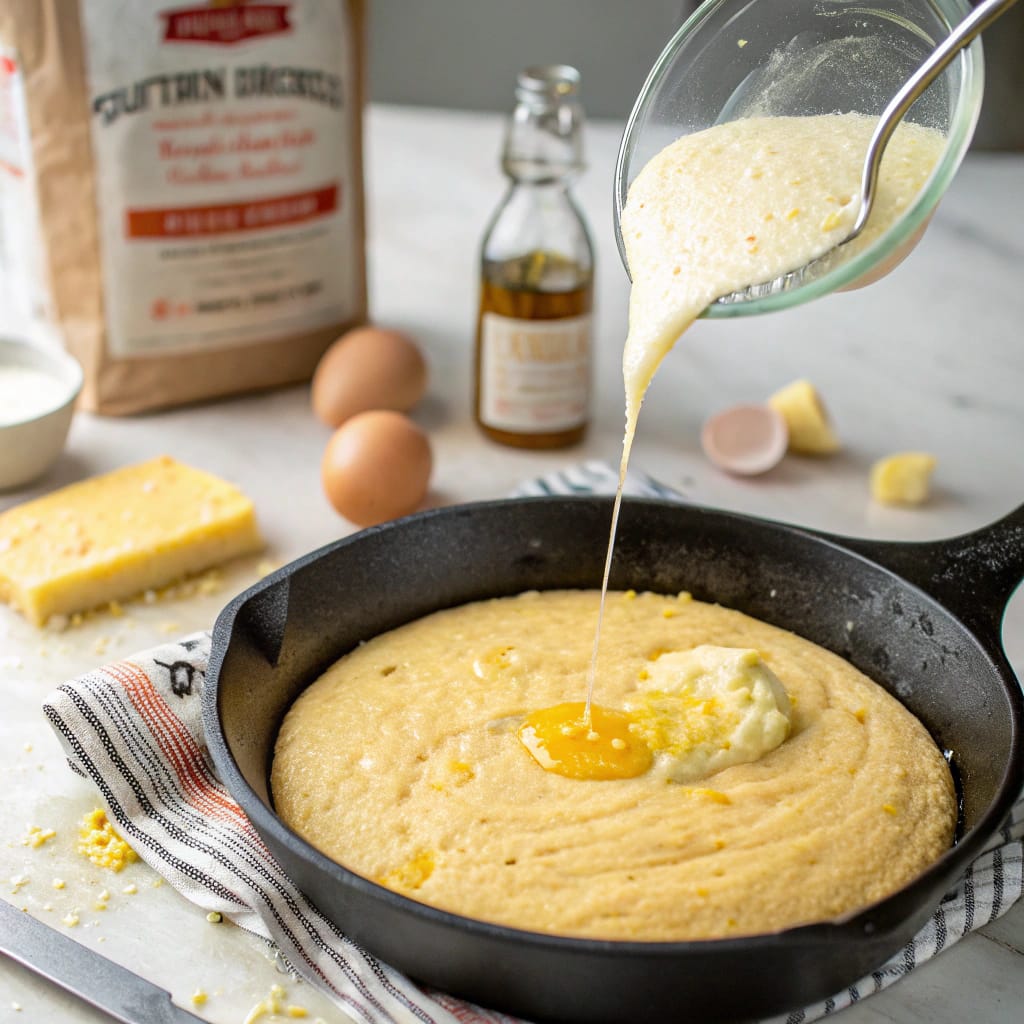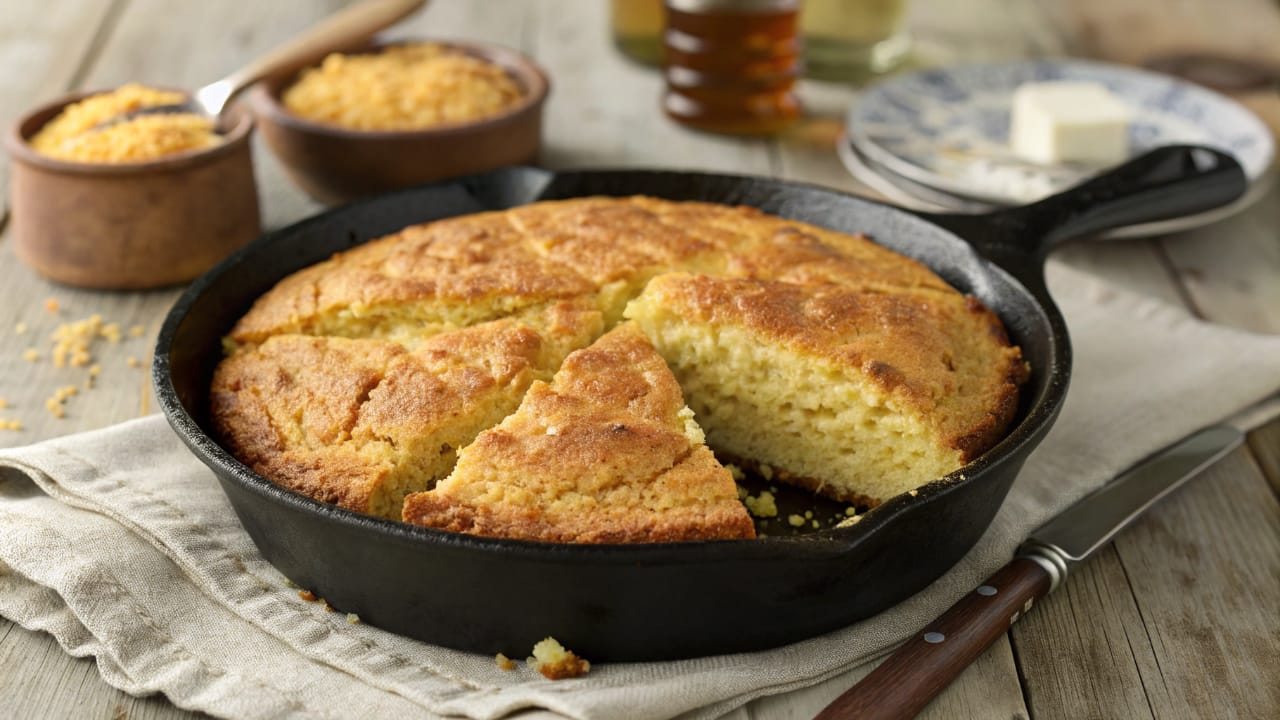Introduction to Southern vs Regular Cornbread
Cornbread is a beloved staple in many households, especially in the Southern United States. The question that often arises among food lovers is, What’s the difference between southern cornbread and regular cornbread? While both types of cornbread have similar ingredients, they differ significantly in texture, flavor, and preparation. This article will dive deep into the comparison between these two variations and provide you with a step-by-step guide to making the perfect southern cornbread recipe.
Understanding Southern Cornbread vs Regular Cornbread
Cornbread is a beloved staple in many households, especially in the South. While there are numerous variations, the key differences between southern cornbread and regular cornbread are mainly in their texture and flavor profiles. Southern cornbread is typically more savory and slightly crumbly due to the absence of sugar, contrasting with regular cornbread, which tends to be sweeter and denser in texture. Another significant difference lies in the type of fat used—southern cornbread often incorporates bacon drippings or lard, which creates a rich, hearty flavor and contributes to a crispy, golden crust. On the other hand, regular cornbread often uses butter or oil, producing a softer, less crispy outer layer. These variations in texture and flavor make southern cornbread the perfect pairing for savory dishes like stews and chili, while regular cornbread is often enjoyed alongside milder dishes. Understanding these differences will help you choose the perfect cornbread to complement your meal.
Key Ingredients in Southern and Regular Cornbread
When it comes to making cornbread, the ingredients play a pivotal role in the final product. For both southern and regular cornbread, you will need a few core ingredients, though the ratio and selection may differ slightly.
Southern Cornbread Ingredients vs Regular Cornbread Ingredients
- Cornmeal: The main ingredient in both types of cornbread. For southern cornbread, a finer cornmeal is typically used to give it a lighter texture.
- Flour: Southern cornbread may use less flour than regular cornbread, allowing the cornmeal flavor to shine through more prominently.
- Eggs: Eggs are used to help bind the ingredients together. In southern cornbread, the use of eggs tends to be more generous.
- Baking Powder: This helps the bread rise, but too much will make the cornbread taste too bitter.
- Buttermilk: A signature ingredient in southern cornbread, providing a tangy flavor and moisture.
- Salt and Sugar: Sugar is often kept to a minimum in southern cornbread, focusing on a savory flavor profile.
Regular Cornbread Ingredients:
- Cornmeal: Regular cornbread may use a coarser cornmeal, which gives it a grainier texture.
- Flour: More flour is typically included in regular cornbread, making it softer and fluffier.
- Eggs: Fewer eggs are usually required, creating a less dense texture.
- Baking Powder: Used in a higher quantity to ensure that the cornbread rises significantly.
- Milk: Regular cornbread often uses regular milk instead of buttermilk, making it milder in flavor.
- Salt and Sugar: Sugar is often added generously in regular cornbread, giving it a sweeter taste.
The Role of Cornmeal in Both Recipes
Cornmeal is the essential ingredient that gives cornbread its distinct flavor and texture. While both southern and regular cornbread recipes use cornmeal, the grind of the cornmeal can affect the final product. Southern cornbread often uses coarser cornmeal, resulting in a more textured, gritty bread. This makes the bread crumbly and able to hold up against the rich stews it’s often served with. On the other hand, regular cornbread may call for a finer grind, which creates a smoother, cake-like texture. The choice of cornmeal affects the mouthfeel and consistency of the bread, and some recipes even combine fine and coarse cornmeal for a balanced texture. Cornmeal also provides the distinct flavor that makes cornbread so unique, and whether coarse or fine, it plays a pivotal role in both versions.
Essential Tools Needed for Cornbread Preparation
To prepare a delicious batch of cornbread, having the right tools is essential. Here’s what you will need
- Mixing Bowl: A large bowl to combine all the dry ingredients and wet ingredients.
- Whisk: To ensure that the dry ingredients are fully combined and that there are no clumps in the batter.
- Measuring Cups and Spoons: Accuracy is key in cornbread preparation, so having precise measurements is crucial.
- Cast-Iron Skillet: “It retains heat well and creates a crispy, golden crust.”
- Baking Pan: For regular cornbread, a standard 9×9-inch square pan or round cake pan works well.
- Spatula: To help scrape the batter into the pan.
- Oven: Preheating your oven is essential for ensuring even cooking.
Step-by-Step Guide to Making Cornbread
“Making cornbread is straightforward, but there are some key differences in terms of preparation. Below is a detailed breakdown of how to prepare each version:”
Preparing Ingredients for Southern and Regular Cornbread
- Measure Your Ingredients: Begin by measuring out your cornmeal, flour, baking powder, sugar (if using), and salt. You’ll also need to measure out buttermilk (for southern cornbread) or milk (for regular cornbread), eggs, and melted butter or oil.
- Mix Dry Ingredients: In a large mixing bowl, whisk together the cornmeal, flour, baking powder, and salt. Ensure the mixture is well-combined before adding any wet ingredients.
- Mix Wet Ingredients: In a separate bowl, whisk together the buttermilk, eggs, and melted butter (or oil). For regular cornbread, replace the buttermilk with milk.
- Combine Wet and Dry Ingredients: Slowly pour the wet ingredients into the dry ingredients, stirring gently to combine. Do not overmix the batter; some lumps are okay. Overmixing can result in tough cornbread.

How to Make the Perfect Southern Cornbread
When it comes to making southern cornbread, the key is in the preparation. First, preheat your oven and prepare a cast-iron skillet, as it ensures the cornbread develops a crispy crust that’s characteristic of southern cornbread. To make the batter, combine cornmeal, flour, salt, and baking powder. Add buttermilk and eggs, followed by bacon drippings or lard. The fat is essential for flavor and texture, so don’t skip this step! Pour the batter into the preheated skillet and bake until golden brown and crispy on top. The beauty of southern cornbread lies in its simplicity—few ingredients are needed, but it delivers a robust flavor that pairs perfectly with savory dishes. Some cooks even recommend letting the batter sit for a few minutes before baking, allowing the cornmeal to fully hydrate, which results in a more tender texture. Don’t forget the final touch: a dollop of honey or jam can complement the savory notes for a delightful contrast.
Cooking Techniques for Southern and Regular Cornbread
- Preheat the Oven:”Preheat your oven to 400°F (200°C). If you’re using a cast-iron skillet, place it in the oven as it preheats.”
- Prepare the Pan: Grease your pan with a little butter or oil to prevent the cornbread from sticking. If using a cast-iron skillet, the skillet will already be hot and will provide a crispy texture.
- Pour the Batter into the Pan: Once your pan is ready, pour the cornbread batter into the prepared pan or skillet, spreading it evenly.
- Bake the Cornbread: For both versions, bake the cornbread for 20 to 25 minutes, or until a toothpick inserted into the center comes out clean. Keep an eye on the cornbread to prevent overbaking, as this can make it dry.
Simmering and Adding Flavor to Cornbread
Once your cornbread is out of the oven, you can enhance the flavor by adding a few optional ingredients:
- Southern Cornbread: Top with a pat of butter or drizzle with honey for extra richness.
- Regular Cornbread: Add a sprinkle of sugar on top or a dash of cinnamon for a sweet kick.
Variations of the Recipe
While the classic southern and regular cornbread recipes are wonderful on their own, there are several variations that can cater to different tastes or dietary restrictions. Here are a few ideas:
- Cheddar Cornbread: Add shredded cheddar cheese to the batter for a savory, cheesy twist.
- Jalapeño Cornbread: Spice up your cornbread by incorporating chopped jalapeños or other chili peppers.
- Cornbread with Bacon: Add crispy, crumbled bacon to the batter for a smoky, savory flavor.
- Gluten-Free Cornbread: Substitute the flour with a gluten-free flour blend to make this recipe gluten-free.
- Vegan Cornbread: Replace the eggs and buttermilk with plant-based alternatives like flaxseed and almond milk.
find out how to make Prime Bites protein brownies at home.
Tips for Perfecting Regular Cornbread
For regular cornbread, the focus is on achieving a moist, soft crumb with a light texture. Start by combining dry ingredients like flour, cornmeal, sugar, and baking powder. Sugar is crucial in regular cornbread to give it that sweet flavor. For the wet ingredients, mix milk, eggs, and melted butter together. Some recipes might call for sour cream or yogurt for added moisture and richness. Once the batter is combined, pour it into a greased baking dish and bake until the top is golden and a toothpick comes out clean. Regular cornbread can be served warm or at room temperature, and while it’s often enjoyed with sweeter dishes, it also pairs beautifully with hearty mains like fried chicken or roast meats. If you want to make it even fluffier, you can fold in whipped egg whites before baking, giving it an airy texture.
Common Mistakes and How to Avoid Them
Although cornbread is a simple recipe, there are a few common mistakes that can result in a less-than-perfect batch. Here’s how to avoid them:
- Overmixing the Batter: Overmixing the batter can lead to tough, dense cornbread. Mix the ingredients just until combined to keep the texture light and fluffy.
- Using the Wrong Pan: A non-stick pan can sometimes result in cornbread that doesn’t brown properly. Use a cast-iron skillet for a crispier, golden crust.
- Underbaking or Overbaking: Make sure to check for doneness using a toothpick. Undercooking can leave your cornbread soggy, while overbaking can make it dry.
- Incorrect Proportions: Stick to the recommended measurements, especially when using buttermilk, as too much liquid can make the cornbread too wet.
Nutritional Benefits
Both southern and regular cornbread offer a variety of nutritional benefits. While they are typically higher in carbohydrates, they provide essential nutrients when enjoyed in moderation.
- Cornmeal: Rich in fiber, cornmeal aids digestion and provides long-lasting energy.
- Eggs: An excellent source of protein and healthy fats, eggs contribute to muscle repair and growth.
- Buttermilk: In southern cornbread, buttermilk is a great source of calcium, which is important for bone health.
- Vitamins and Minerals: Cornbread made with enriched flour also provides essential vitamins like folic acid and iron.
Pairing with Sides and Drinks
Cornbread is versatile and pairs well with many sides and drinks. Here are some great options:
- Sides:
- Collard greens
- Fried chicken
- Grilled vegetables
- Chili
- Drinks:
- Sweet tea
- Lemonade
- Buttermilk
If you’re looking for a delicious twist on a classic dessert, check out this moist blueberry pound cake recipe or explore blueberry pound cake variations for more ideas!
Conclusion: A Simple and Versatile Recipe
In conclusion, What’s the difference between southern cornbread and regular cornbread? While both recipes share common ingredients, the key differences lie in their textures, ingredients, and regional variations. Southern cornbread tends to be more savory, with a denser texture and more distinctive flavor thanks to the buttermilk. Regular cornbread, on the other hand, is fluffier, sweeter, and more versatile for various flavor additions. Regardless of which version you choose, cornbread is a simple and versatile recipe that can complement any meal.


4 thoughts on “What’s the Difference Between Southern Cornbread and Regular Cornbread?”